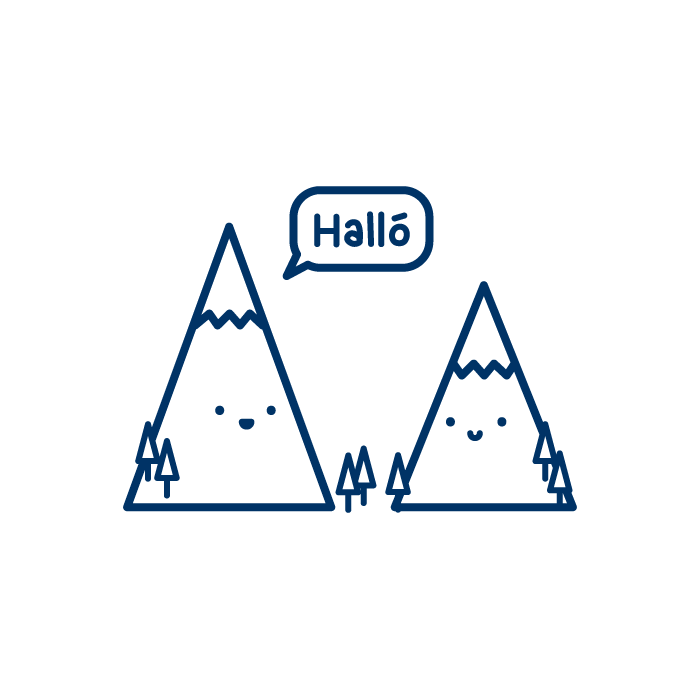
Futbol vikings, moonbeams, Björk—Iceland has long-since captured the global imagination, often capitalizing on foreign fascination. Tourism has been essential to the country’s post-crash economic recovery and guerrilla activities in the form of social media have emerged as a complement to ad campaigns and travel initiatives. Put simply, the posted image is the new word of mouth and Iceland is Instagrammer heaven. When cabin porn is a noun-ed phenomenon, Grade-A bragging visuals have brought hordes of visitors and money to the Nordic island. However, the influx has not been without anxiety. One Instagram account embodies the bane and boon of tourism for contemporary Icelandic identity.
Every Single Word in Icelandic, @everysinglewordinicelandic, is one of the most charming mini-galleries around. The concept is simple: pictographs break down the etymology of Icelandic words, illustrating cultural personality and the magic of language while teaching interested followers a thing or two.
Created by Eunsan Huh, a graphic designer who began learning Icelandic in New York City, many Every Single Word entries are Icelandic symbology: wool sweater, hot dog, whale (peysa, pylsa, hvalur). Others reflect Iceland’s absorption of new practices. In a shepherding country, chopsticks are called matprjónar or “food knitting needles.” Idioms also pop up—in Icelandic a tough cookie could be called a harðjaxl, a “hard molar.” The ranks of the account’s followers has steadily grown. Particularly in terms of nature and ‘folk’ attitudes, we seem collectively predisposed to being amused by Iceland the way audiences at comedy shows come ready to laugh.

Image by Eunsan Huh
The interest in Icelandic is certainly welcome. A language spoken by about 300 000 people must work to preserve itself. Reliance on importation and a history of Danish rule make Iceland no stranger to fears of foreign influence. A vital function of the Icelandic Language Council is to establish Icelandic words for new inventions. Drawing on Old Norse and Icelandic roots, the goal is to prevent an influx of loanwords—once Danish, now English—from taking over. Some borrowed words have taken hold—the use of banani far surpasses bjúgaldin “sausage fruit”—but preservation efforts have paid off in terms of language survival and intrigue. The word for television is a popular example that reminds us of how strange tv was upon its invention, as well as of the beauty of the English word. Sjónvarp breaks down into “vision caster.” Tele-vision. It may seem obvious, augljós, (auga< , eye, + ljós, light), but is there anything we take more for granted?
A vital function of the Icelandic Language Council is to establish Icelandic words for new inventions. Drawing on Old Norse and Icelandic roots, the goal is to prevent an influx of loanwords—once Danish, now English—from taking over.Perhaps one thing. The internet, whose here-to-eternity English poses an unprecedented threat to Iceland’s notoriously difficult, poetic, and odd tongue. Icelandic schooling has long included English, Danish, Latin, and various other languages, but English is particularly alluring for young people looking to participate in global arenas. Not just the online, but in technology use in general. As the Icelandic writer Sjón put it in an interview I conducted with him for Asymptote International Literary Journal,“When the day comes that we have to speak to our refrigerators in English (which I believe is not far in the future), Icelandic will retreat very fast.”
Former President of Iceland Vigdis Finnbogadóttir drew an oft-repeated distinction: Icelandic is not a ‘small language’ but rather ‘a language spoken by few.’ According to Finnbogadóttir, an active linguistic advocate (and the world’s first elected woman head of state—fewer speakers often boast when they can), there are no small languages. This rings true to anyone who has been mouth-baffled in a land of extensive compound words. It is not a numbers game, but hundreds of years of Nordic literature—an immeasurable contribution to world culture and mythology—is contingent on linguistic knowledge.
Fans of Every Single Word would likely agree. A playground for language nerds, Scandophiles, and suckers for design, the account has partnered with Icelandic cultural organizations like The Grapevine. Audio recordings have been added to aid with pronunciation. The potential for learning and exchange is apparent. And yet, it is impossible not to be ambivalent about the central irony: the language is threatened by the very medium people use to discuss it. For years technology has helped Icelandic art reach new audiences, tributaries that lead to a sea of Anglophone cultural capital. Naturally, this is more true of writing than music or visual art. The Grapevine is an English Reykjavík-based magazine. A panel of Icelandic authors was held at Scandinavia House earlier this year to celebrate the launch of “Beneath the Ice: An Anthology of Contemporary Icelandic Poetry”—in English translation. After a bilingual reading and led discussion, an audience member asked why the authors do not write in English, since their “English is quite good.” They could, but then where would Icelandic literature come from? What would happen to the language itself?
Community is fostered in each post—people tag their travel companions, Icelanders chime in to answer questions and offer corrections, fans request specific words.
Despite its name, Every Single Word doesn’t claim to lead to fluency. It is a heartwarming nugget, not a forum for semantic critique. Community is fostered in each post—people tag their travel companions, Icelanders chime in to answer questions and offer corrections, fans request specific words. Most exchanges occur in English, further demonstrating Brexit-proof linguistic dominance.
The optimistic style of the illustrations is a major part of the account’s appeal, as are its sprightly references to the natural world—volcanoes, glaciers, sea creatures. Scrolling through the feed in the New York subway, on what we call smartphones, on the internet—a plane fueled by the imagination of strangers and codes many of us don’t understand—we are reminded of the ground beneath our feet. The Icelandic word for Earth is heimur. Heim is home. With a rookie’s attention to ingredients it is easier to note the connection of basic elements. Snowflake, snjókorn, breaks down into “snow grain.” Bergmál, “rock face language.” Aka echo. Sensible enough.
Snjókorn
Image by Eunsan HuhSomething essentially human is at work under these virtual reminders of physicality. In atrocious times there is comfort in every nod to our shared experience. Heartbreak is ástarsorg, “love sadness.” Translation and sharing are the basis of empathy and ‘following.’
Every Single Word also throws a spotlight on language as artifact. These are icons, after all. When meaning is distilled into pure significance it becomes sacred, a button to be pushed, or both. Before logos, subliminal cues of consumer recognition, there was logos—reason and the word. It’s fun to puzzle over the Every Single Word drawings, to guess the word based solely on depiction.
Pictograms offer a kind of universalism to those who can view them. Accessibility is key to the eternal popularity of hieroglyphics—onlookers don’t need to speak a certain language to see them. Everyone brings eyes and associations but variation is mediated by utilitarian, traffic-sign logic. On the other hand, wonder comes from the unknown. Unfamiliarity provides the distance we need to be stunned by the beauty of a concept or phrase. Whether we grasp the logic or can’t quite relate, there is pleasure in the exchange.
Is it an insult to a language’s illustrious history to compare between these images with the newest emoji keyboard? Perhaps, but that doesn’t make it less apt, and the evolution of such keyboards is remarkable. As representation becomes more accurate and inclusive, new possibilities register in our collective understandings of reality. Words and word-pictures shape our view of the world, giving options and form to the thinks we can think.
The fate of Icelandic and other languages spoken by few remains to be seen, read, and heard. For now, as with anything, we can take the mixed bag, if we believe we have a choice.
Tomorrow’s folk tale might be a cautionary yarn about the Pokémon hunter who fell into Goðafoss. Purists might cringe at the notion, romantics might refuse to read it—or watch the trailer. There is much to bemoan about the evolving tension between technology and our physical and social lives: bodily detachment, fractured attention, intimate dis-ease. Worries about Icelandic are well-founded, but its speakers are aware. Gerður Kristný responded to the ‘why not write in English’ question by explaining that language has so much to do with Icelandic independence and identity, she will always write in Icelandic. It is her language. Technology looms, but pride and artistry is made of different stuff. Human obstinacy is a phenomenon unto itself.
The fate of Icelandic and other languages spoken by few remains to be seen, read, and heard. For now, as with anything, we can take the mixed bag, if we believe we have a choice. Absorbing positive resonance when we can is a coping skill as venerable as sagas. Marveling at inventions creates space for thought about how to use them well.
Rarity may protect languages via the kind of cult interest Icelandic enjoys. Print was supposed to be dead by now, or the realm of fetishized art objects and eccentric collectors. Yet book-devices haven’t supplanted books themselves. There are simply more ways to read. The internet is akin to Borges’ Babel in both threat and potential—it cultivates a browsing attitude that eats its children but also offers a place to be intentionally communicative. Never have we had such a grand chance to self-define or such an audience for our own terms.
Hljómsveit
Image by Eunsan Huh“Orchestra” is a pertinent Every Single Word in Icelandic entry. Hljómsveit, literally “sound team.” The ancient chorus persists, in one form or another, and it is what we make of it.


